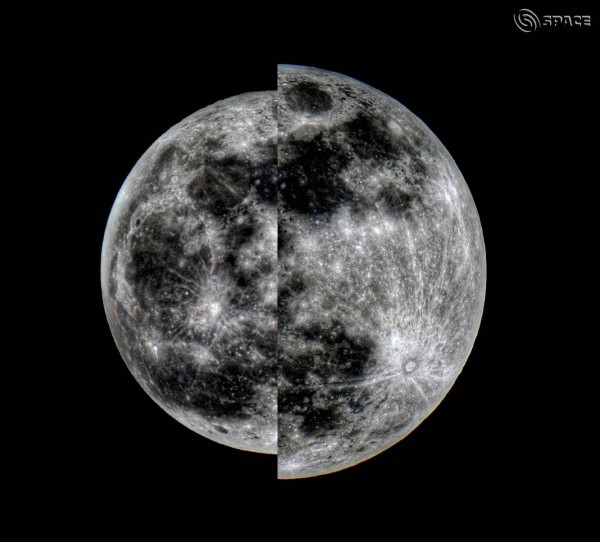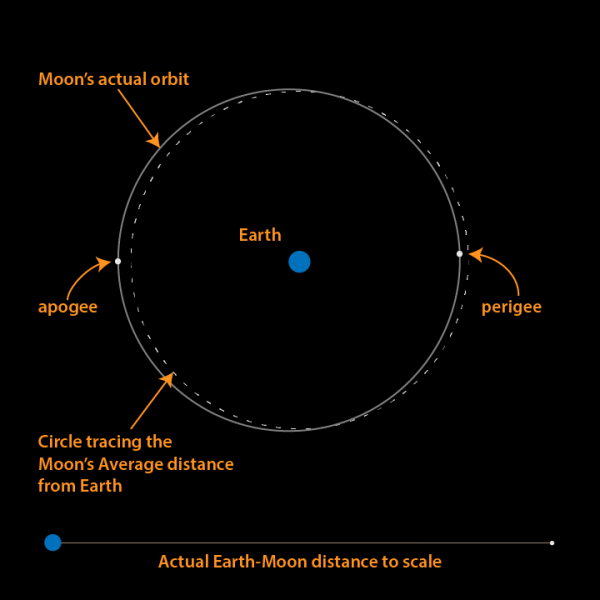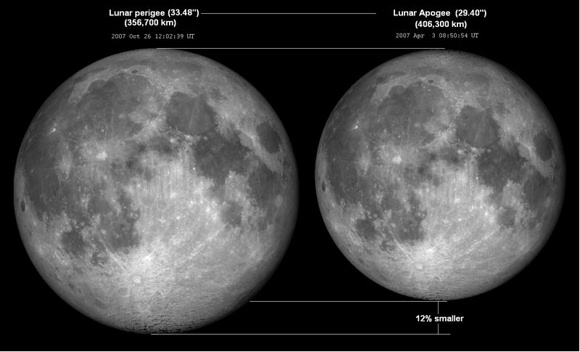
The September 27-28, 2015 moon is full moon – a supermoon – the Harvest Moon – and it’s going to undergo an eclipse!
In September 2015, the moon sweeps to perigee – the moon’s closest point to Earth for the month – on September 28 at 1:46 UTC. That is September 27 at 8:46 p.m. CDT. This month’s moon at its perigee lies 356,877 kilometers (221,753 miles) from Earth. It’s the moon’s closest point to Earth for all of 2015.
The year’s closest perigee is sometimes called the moon’s proxigee.
And there’s more. About one hour after the September 27-28 lunar perigee, the moon will reach the crest of its full phase. That’ll happen at 2:51 UTC. The very close coincidence of perigee and full moon will showcase not only the closest supermoon of 2015, but also a lunar eclipse on night of September 27-28.
Plus, it’s the Harvest Moon for us in the Northern Hemisphere!
We list the dates for this year’s 13 lunar apogees (farthest points) and 13 lunar perigees (nearest points), below:

Lunar apogees and perigees in 2015
| Apogee | Perigee | |
| January 9 | January 21 | |
| February 6 | February 19 | |
| March 5 | March 19 | |
| April 1 | April 17 | |
| April 29 | May 15 | |
| May 26 | June 10 | |
| June 23 | July 5 | |
| July 21 | August 2 | |
| August 18 | August 30 | |
| September 14 | September 28 | |
| October 11 | October 26 | |
| November 7 | November 23 | |
| December 5 | December 21 |
Enjoying EarthSky so far? Sign up for our free daily newsletter today!
Amazingly, in periods of four years, lunar apogees and perigees fall on the same, or nearly the same calendar dates. Let’s look four years ahead, to the year 2019:
Lunar apogees and perigees in 2019
| Apogee | Perigee | |
| January 9 | January 21 | |
| February 5 | February 19 | |
| March 4 | March 19 | |
| April 1 | April 16 | |
| April 28 | May 13 | |
| May 26 | June 7 | |
| June 23 | July 5 | |
| July 20 | August 2 | |
| August 17 | August 30 | |
| September 13 | September 28 | |
| October 10 | October 26 | |
| November 7 | November 23 | |
| December 5 | December 18 |
Also, in cycles of two years, the calendar dates remain the same, or nearly so, except that the lunar apogees and perigees trade places. For instance, let’s look two years beyond 2015, to the year 2017:
Lunar apogees and perigees in 2017
| Apogee | Perigee | |
| January 22 | January 10 | |
| February 18 | February 6 | |
| March 18 | March 3 | |
| April 15 | March 30 | |
| May 12 | April 27 | |
| June 8 | May 26 | |
| July 6 | June 23 | |
| August 2 | July 21 | |
| August 30 | August 18 | |
| September 27 | September 13 | |
| October 25 | October 9 | |
| November 21 | November 6 | |
| December 19 | December 4 |
Want to know more? Click here for a complete listing of all lunar perigees and apogees for the 21st century (2001 to 2100).
It’s hard to believe that this rather straight-forward four-year apogee/perigee cycle is so little known among professional astronomers and lay people alike. Lunar apogees and lunar perigees align on the same, or nearly the same calendar dates every four years, because 53 returns to perigee (or apogee) is nearly commensurate with four calendar years. The mean length of the anomalistic month (perigee to perigee, or apogee to apogee) is 27.55455 days, whereas the average Gregorian year equals 365.2425 days. Hence:
27.55455 x 53 = 1460.3912 days
365.2425 x 4 = 1460.97 days

Bottom line: In periods of four years, lunar apogees and perigees fall on the same, or nearly the same calendar dates.











